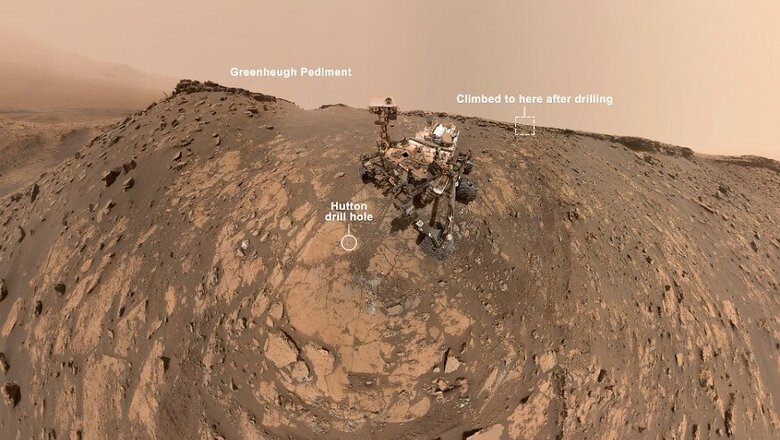
views
NASA's Curiosity rover has sent us yet another epic photograph from the Martian surface, this time a selfie that is more than worthy of featuring in trendy Instagram Stories. On February 26, the Curiosity rover drilled a hole near the Greenheugh Pediment, a rocky highland area on Mars, and proceeded to use its medium-angle 'left eye' camera to take a surround photograph that includes the Martian land, the Hutton drill hole in front of the rover's wheels, Curiosity itself, and the Greenheugh Pediment in the background. Had it not been for the ominous, post-apocalyptic ferrous oxide shade of the Martian sky, this photo could have been passed off as being taken in an alternate setting here on Earth.
It then proceeded to take on another record setting task — climb one of the steepest slopes that any mankind-build creation has managed to climb outside of Earth. Approaching the crumbling ridge of the Greenheugh Pediment, Curiosity nearly matched the all-time record set by NASA's iconic Opportunity Mars rover by climbing an incline of 31 degrees. Curiosity's feat will further validate the rover's rocker-bogie wheel system, which allows it to tilt by up to 45 degrees on an incline without any danger of flipping over. However, in a statement detailing the feat, NASA officials did say that as a result of Curiosity's adventures, there is the odd occasion of wheel spin that explains the complications of its climb.
The selfie itself was taking in over 86 individual photos, which were then stitched together by NASA scientists back at home to create the singular, expansive photograph that has now been released for the world to see. Curiosity has been instrumental in its scientific targets, but one of its landmark feats, for which it would be remembered long, is the 1.8-Gigapixel panorama shot of the Martian surface, stitched together from over 1,000 photographs, detailing a desolate, melancholic Martian surface that may have once held traces (or more) of life.
Part of Curiosity's mission was to identify whether the Martian surface holds any clue towards hosting water on its surface or sub-surface at some point of time. It landed inside the 154 kilometre-wide gigantic Gale crater, and identified just that, following which we could affirm that Mars was indeed a warm, wet world, at least at some point of time in the past. Curiosity is still going strong with its research work, sending data back to Earth to help scientists understand why Mars transitioned in the cold, barren place that it is today, and what exactly happened to its atmosphere. Curiosity is also collecting Martian rock samples, which will be sent back to Earth to study for the first time ever.
With NASA's legendary Opportunity rover now defunct, Curiosity will rove the Martian surface all alone, until it is joined by the life-hunting NASA probe, Perseverance, which is so far scheduled to land on Mars some time in February 2021.




















Comments
0 comment